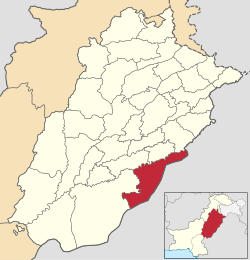Bahawalnagar District (Urdu and Punjabi: ضلع بہاولنگر), is a district of Punjab province in Pakistan. Before the independence of Pakistan, Bahawalnagar was part of Bahawalpur state governed by the Nawab of Bahawalpur. The city of Bahawalnagar is the capital of the district.[3]
Bahawalnagar
ضلع بہاولنگر | |
|---|---|
Top: Marot Fort Bottom: Fields in Chak 38-R | |
 Map of Bahawalnagar District (highlighted in red) within Punjab. | |
| Country | |
| Province | |
| Division | Bahawalpur |
| Headquarters | Bahawalnagar |
| Government | |
| • Type | District Administration |
| • Deputy Commissioner | Muhammad Waseem |
| • District Police Officer | Muhammad Essa Khan Sukhera |
| Area | |
| 8,878 km2 (3,428 sq mi) | |
| Population | |
| 3,550,342 | |
| • Density | 400/km2 (1,000/sq mi) |
| • Urban | 974,118 |
| • Rural | 2,576,224 |
| Literacy | |
| • Literacy rate |
|
| Time zone | UTC+5 (PKT) |
| Area code | 063 |
| No. of Tehsils | 5 |
| Tehsils | Bahawalnagar Chishtian Fort Abbas Haroonabad Minchinabad |
| Website | bahawalnagar |
District boundaries
editThe boundaries of Bahawalnagar in the east and south touches the Indian territory of Bikaner and Firozpur districts[4] while Bahawalpur district lies on its west and river Sutlej flows on its northern side. District Bahawalnagar spreads over an area of 8878 square kilometers.[5]
Administration
editThe district of Bahawalnagar is spread over an area of 8,878 square kilometres (3427.8 square miles) comprising five tehsils and 118 Union Councils:[6]
| Tehsil[7] | Area
(km²)[8] |
Pop.
(2023) |
Density
(ppl/km²) (2023) |
Literacy rate
(2023)[9] |
Union Councils |
|---|---|---|---|---|---|
| Bahawalnagar[6] | 1,729 | 976,049 | 564.52 | 53.5% | 31 |
| Chishtian[6] | 1,500 | 845,439 | 563.63 | 60.49% | 29 |
| Fort Abbas[6] | 2,536 | 510,253 | 201.20 | 61.36% | 16 |
| Haroonabad[6] | 1,295 | 615,476 | 475.27 | 66.28% | 22 |
| Minchinabad[6] | 1,818 | 603,125 | 331.75 | 44.05% | 20 |
| Total | 2,981,919 | 118 |
Demographics
edit| Year | Pop. | ±% p.a. |
|---|---|---|
| 1951 | 630,430 | — |
| 1961 | 822,827 | +2.70% |
| 1972 | 1,073,891 | +2.45% |
| 1981 | 1,373,747 | +2.77% |
| 1998 | 2,061,447 | +2.42% |
| 2017 | 2,975,656 | +1.95% |
| 2023 | 3,550,342 | +2.99% |
| Sources:[10] | ||
In 2023, the district had 558,333 households and a population of 3,550,342.[1]
Religion
editIn 2023, 19,653 (0.55%) were from religious minorities, of which Christians were 14,577, Hindus (incl. Scheduled Castes) 3,106, Ahmadi 1,598, Sikhs 39, Parsis 2, and 331 others.[11]
Languages
editAt the time of the 2023 census, 94.08% of the population spoke Punjabi, 1.74% Saraiki and 3.35% Urdu as their first language.[12]
History
editNawab Bahawal Khan-1[13] as second nawab of Bahawalpur ascended the throne in 1746 A.D.
Muhammad Mubarik, after ruling successfully for years, died issueless in 1772 A.D. He was succeeded by his nephew Sahibzada Jafar Khan alias Nawab Muhammad Bahawal Khan-II[14] in 1772.
Shrine of Tajuddin Chishti
editShaikh Khawaja Tajuddin Chishti also known as Taj Sarwar Chishti was a Sufi saint of Chishti Order. He was a grandson Shaikh Farid-ud-din Ganjshakar of Pakpattan and his descendants founded the village of Chishtian around 1265 CE (574 Hijri, Islamic calendar). Many native tribes in Punjab region accepted Islam due to his missionary Daawah. Shaikh Khawaja Tajuddin Chishti faced hostility from many Mughal and Turk tribes that opposed his Muslim missionary Daawah as it interfered with their plans and he was martyred in a battle and was buried in Chishtian. Shrine of Sufi saint Shaikh Khawaja Tajuddin Chishti, located at the city of Chishtian. The dargah of Shaikh Taj-ud-din Chishti is called Roza Taj Sarwar.[15]
See also
editReferences
edit- ^ a b "TABLE 1 : HOUSEHOLDS, POPULATION, HOUSEHOLD SIZE AND ANNUAL GROWTH RATE" (PDF). www.pbscensus.gov.pk. Pakistan Bureau of Statistics. 2023.
- ^ "Literacy rate, enrolments, and out-of-school population by sex and rural/urban, CENSUS-2023" (PDF).
- ^ "Bahawalnagar District - population per 2017 Census of Pakistan (scroll down to page 8 of 16 for Bahawalnagar District)" (PDF). Pakistan Bureau of Statistics, Government of Pakistan website. Archived from the original (PDF) on 7 November 2017. Retrieved 14 December 2023.
- ^ "District Overview Bahawalnagar". District Overview Bahawalnagar. District Police Bahawalnagar. Retrieved 27 January 2023.
- ^ "Bahawalnagar". Punjab Portal, Government of Pakistan website. Archived from the original on 14 October 2012. Retrieved 14 December 2023.
- ^ a b c d e f "Tehsils & Unions in the District of Bahawalnagar". National Reconstruction Bureau, Government of Pakistan website. Archived from the original on 9 February 2012. Retrieved 14 December 2023.
- ^ Divisions/Districts of Pakistan Archived 2006-09-30 at the Wayback Machine Note: Although divisions as an administrative structure has been abolished, the election commission of Pakistan still groups districts under the division names
- ^ "TABLE 1 : AREA, POPULATION BY SEX, SEX RATIO, POPULATION DENSITY, URBAN POPULATION, HOUSEHOLD SIZE AND ANNUAL GROWTH RATE, CENSUS-2023, PUNJAB" (PDF).
- ^ "LITERACY RATE, ENROLMENT AND OUT OF SCHOOL POPULATION BY SEX AND RURAL/URBAN, CENSUS-2023" (PDF).
- ^ "Population by administrative units 1951-1998" (PDF). Pakistan Bureau of Statistics.
- ^ a b "Population by Sex, Religion, and Rural/Urban, Census-2023" (PDF). Pakistan Bureau of Statistics. 2023. Retrieved 1 August 2024.
- ^ a b "Population by Mother Tongue, Sex and Rural/Urban, Census-2023" (PDF). Pakistan Bureau of Statistics. 2023. Retrieved 1 August 2024.
- ^ "Bahawalpur Princely State - History of its Rulers". Cholistan Development Authority, Government of Pakistan website. Archived from the original on 24 October 2016. Retrieved 14 December 2023.
- ^ "Bahawalpur City - Ruler Nawabs of Bahawalpur State". Archived from the original on 8 February 2013. Retrieved 14 December 2023.
- ^ "Shrine of Tajuddin Chishti, Chishtian, Bahawalnagar". Merawatan.pk website. Retrieved 14 December 2023.

